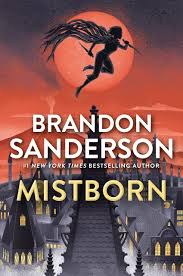
Mistborn: The Final Empire
17
by Sanderson, BrandonVin finds herself confined to the luxurious but stifling environment of Mansion Renoux while recovering from her injuries. Though surrounded by the beauty of cultivated gardens—a stark contrast to her former life—she chafes under the idle routine of noble life. Servants attend to her every need, leaving her restless and frustrated. Forbidden from Allomancy training and with Sazed preoccupied by his translation work, Vin feels trapped in a role that demands passivity, a far cry from her adventurous past.
Her interactions with Lord Renoux highlight the disconnect between their worlds. He treats her with distant courtesy, focusing on ledgers and trivialities like shopping trips, while Vin struggles to maintain her noble facade. The arrival of Kelsier and the crew offers a brief reprieve from her boredom, signaling a return to the world of action and intrigue. Kelsier’s presence, though still marked by a newfound thoughtfulness, reassures Vin that her confinement is temporary.
The chapter contrasts Vin’s growing impatience with the serene opulence of noble life. The vibrant gardens and attentive servants serve as a backdrop to her inner turmoil, emphasizing her discomfort with luxury and inactivity. Her refusal to replace her mother’s earring symbolizes her resistance to fully adopting the noble identity, a small act of defiance amidst her forced compliance.
The crew’s arrival hints at upcoming developments, breaking the monotony of Vin’s recovery. Kelsier’s relaxed demeanor and the crew’s presence suggest a return to their mission, reigniting Vin’s hope for purpose and adventure. The chapter underscores her struggle to reconcile her past with her current role, setting the stage for her eventual reintegration into the crew’s plans.
FAQs
1. How does Vin’s perception of noble life change in this chapter, and what specific experiences contribute to this shift?
Answer:
Vin initially viewed noble pursuits like ornamental gardens as frivolous, but her time at Mansion Renoux exposes her to their beauty and craftsmanship. The carefully arranged vibrant plants and shaded balconies impress her, though she finds the luxurious lifestyle stifling. Her frustration stems from forced inactivity due to her injury, excessive pampering by servants, and the monotony of playing a noblewoman. This chapter highlights her conflicted perspective: she appreciates aesthetic pleasures but chafes at the idleness of noble life, noting how it drives women to seek excitement at balls (e.g., her thought: “No wonder everyone’s eager to attend those balls!”).2. Analyze the significance of Vin’s mother’s earring in this chapter. How does it reflect her character development?
Answer:
Vin’s refusal to replace her mother’s earring despite Renoux’s suggestion symbolizes her lingering attachment to her past identity. The earring represents her traumatic upbringing and distrust, serving as a tangible connection to her mother—a figure tied to both abuse and protection. Her insistence on keeping it (“I’ll keep this”) contrasts with her otherwise successful adaptation to noble decorum, revealing unresolved emotional complexities. This moment underscores her internal struggle: while she adopts new roles for the mission, certain elements of her old self remain non-negotiable, hinting at deeper loyalty and memory than her outward transformation suggests.3. How does Kelsier’s behavior in this chapter demonstrate his evolving leadership style post-palace attack?
Answer:
Kelsier shows increased transparency and collaboration, holding more meetings and sharing plans with the crew—a shift from his earlier secretive tendencies. His thoughtful demeanor (“more … thoughtful”) and willingness to heed Renoux’s caution about visibility (stepping back from the balcony edge) reflect heightened caution and respect for others’ input. However, his playful chair-spinning and quip about spies (“they deserve more than the Great Houses are paying them”) retain his charismatic flair, balancing newfound seriousness with his trademark confidence. This evolution suggests the palace attack impacted his approach, making him more inclusive while maintaining strategic charm.4. What role does Sazed play in this chapter, and how does his subplot enrich the narrative’s thematic depth?
Answer:
Sazed’s obsessive translation of the book mirrors Vin’s restlessness, offering a parallel exploration of purpose. His “uncharacteristically excited air” and hours spent poring over texts highlight the Keepers’ scholarly devotion, contrasting with Vin’s physical confinement. This subplot reinforces themes of knowledge as power and obsession; Vin compares his focus to “streetspice” intoxication, subtly linking intellectual and physical addictions. His absence from her daily life also emphasizes her isolation, deepening the chapter’s tension between growth and stagnation. Through Sazed, Sanderson expands the world’s lore while commenting on how different characters seek meaning.5. How does Sanderson use the garden setting to reinforce Vin’s emotional state and the chapter’s central conflicts?
Answer:
The garden’s beauty (“vibrant colors,” “soothing” rustling leaves) initially offers Vin aesthetic pleasure, symbolizing her growing appreciation for noble culture. Yet its constrained space (“thin perimeter”) mirrors her forced inactivity, while the servants’ “scavenger bird” presence frames luxury as oppressive surveillance. The balcony becomes a liminal space—physically open but socially restrictive—mirroring her role as a spy: visible yet isolated. Even the weather (“mild winter”) reflects her stalled progress. This setting amplifies her tension between admiration for beauty and resentment of confinement, making the environment an active participant in her internal conflict.
